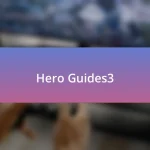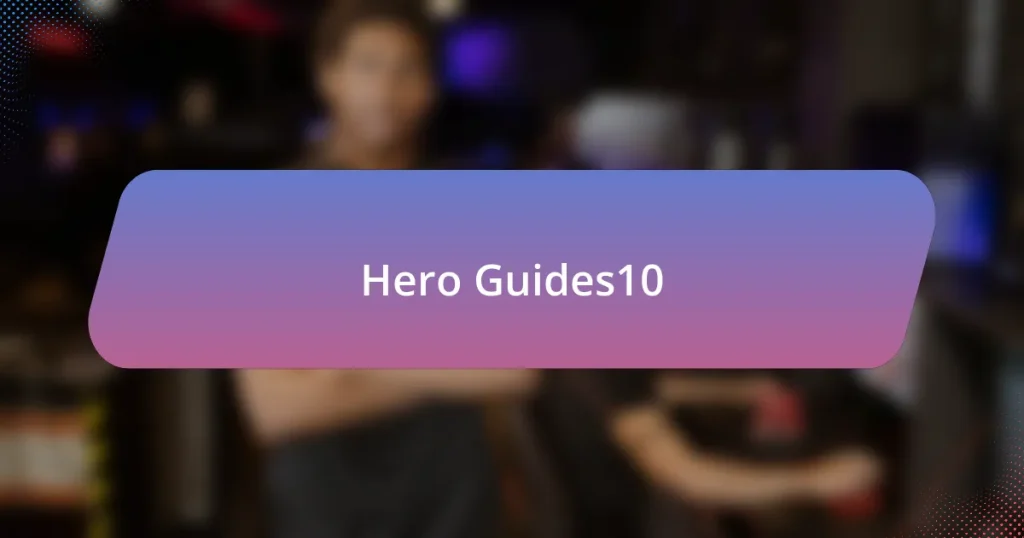Effective item builds for popular heroes are crucial for optimizing gameplay across various roles in competitive gaming. This article provides a comprehensive guide on how item builds enhance hero performance by aligning with their roles and abilities, detailing the impact of core and situational items, and emphasizing the importance of synergy. It also explores the factors that determine the effectiveness of item builds, common mistakes players make, and best practices for adapting builds mid-game. Additionally, the article highlights specific item recommendations for carry, support, and tank heroes, along with strategies for assessing and adjusting item builds based on game dynamics and enemy composition.

What are Effective Item Builds for Popular Heroes?
Effective item builds for popular heroes vary based on their roles and abilities. For example, a typical item build for a carry hero like Anti-Mage includes Battle Fury for farming efficiency, Manta Style for dispelling and mobility, and Black King Bar for survivability in team fights. In contrast, a support hero like Crystal Maiden benefits from Arcane Boots for mana regeneration, Glimmer Cape for invisibility, and Aether Lens for increased spell range. These builds are effective as they enhance the heroes’ strengths and mitigate their weaknesses, ensuring optimal performance in various game scenarios.
How do item builds influence hero performance?
Item builds significantly influence hero performance by enhancing specific attributes and abilities that align with a hero’s role and playstyle. For instance, a damage-focused item build increases a hero’s attack power, allowing them to deal more damage in fights, while a tank-oriented build boosts survivability, enabling the hero to absorb more damage. This strategic selection of items can lead to improved effectiveness in various game scenarios, such as team fights or objectives.
Statistical analysis in competitive gaming shows that optimal item builds can increase win rates by as much as 10-15%, demonstrating the direct correlation between itemization and hero performance. For example, in Dota 2, heroes like Anti-Mage benefit from items that enhance agility and mana burn, directly impacting their ability to outmaneuver opponents and secure kills.
What factors determine the effectiveness of an item build?
The effectiveness of an item build is determined by several key factors, including hero synergy, game context, and opponent composition. Hero synergy refers to how well the items complement the specific abilities and strengths of the hero, enhancing their performance in battles. Game context involves the current state of the match, such as the phase of the game and the team’s overall strategy, which can dictate the most beneficial items to equip. Opponent composition is crucial as it requires adapting the item build to counter the strengths and weaknesses of the enemy heroes, ensuring that the build is effective against specific threats. These factors collectively influence the overall performance and impact of an item build in gameplay.
How do different roles affect item build choices?
Different roles significantly influence item build choices by dictating the primary function and responsibilities of a hero in gameplay. For instance, carries prioritize damage-dealing items to maximize their output, while tanks focus on durability and crowd control to absorb damage and protect teammates. Support roles typically select items that enhance healing, utility, or vision, ensuring they can assist their team effectively. This differentiation in itemization is crucial, as it aligns with the strategic objectives of each role, optimizing team performance and synergy during matches.
Why is it important to have a guide for item builds?
Having a guide for item builds is important because it provides players with structured strategies to optimize their performance in games. Item builds can significantly influence a player’s effectiveness, as they determine the abilities and strengths a character can leverage during gameplay. Research shows that players who follow established item build guides tend to achieve higher win rates, as these guides are often based on extensive analysis of game mechanics and player statistics. For example, a study by the game analytics platform OP.GG indicates that players who adhere to recommended item builds can improve their win rates by up to 15%. This demonstrates that having a guide not only enhances individual performance but also contributes to overall team success.
What common mistakes do players make with item builds?
Players commonly make mistakes with item builds by failing to adapt their choices to the specific game context. This includes not considering the enemy team’s composition, which can lead to ineffective itemization against certain heroes. Additionally, players often prioritize items that do not synergize with their hero’s abilities or playstyle, resulting in suboptimal performance. For example, a tank hero might invest in damage items instead of defensive ones, compromising their survivability in team fights. Furthermore, neglecting to adjust builds based on the game’s progression, such as not transitioning to late-game items when necessary, can hinder a player’s effectiveness. These mistakes are prevalent across various skill levels, highlighting the importance of strategic itemization in gameplay.
How can a well-structured guide improve gameplay?
A well-structured guide can significantly improve gameplay by providing clear strategies and item builds tailored to specific heroes and roles. This clarity allows players to make informed decisions during matches, enhancing their effectiveness and overall performance. For instance, a guide that outlines optimal item progression based on hero strengths and weaknesses enables players to adapt their gameplay to various situations, leading to better resource management and team synergy. Studies in gaming psychology indicate that structured information reduces cognitive load, allowing players to focus on execution rather than decision-making under pressure.

What are the Key Components of Item Builds?
The key components of item builds include core items, situational items, and synergy with hero abilities. Core items are essential for maximizing a hero’s effectiveness and are typically chosen based on the hero’s role and playstyle. Situational items provide flexibility and adaptability to counter specific opponents or enhance certain aspects of gameplay. Synergy with hero abilities ensures that the chosen items complement the hero’s skills, enhancing overall performance in battles. These components are critical for creating effective item builds that optimize a hero’s potential in various scenarios.
How do core items differ from situational items?
Core items are essential components of a hero’s build that provide fundamental benefits and synergies, while situational items are chosen based on specific game circumstances to counter opponents or enhance particular strategies. Core items typically include those that maximize a hero’s primary strengths, such as damage output or survivability, and are generally prioritized in every match. In contrast, situational items are flexible and can vary from game to game, depending on factors like enemy composition or the current state of the match. For example, a hero may always build a core item like a damage amplifier, but may opt for a situational item like a defensive shield if facing heavy burst damage.
What are examples of core items for various heroes?
Core items for various heroes include specific equipment that enhances their abilities and effectiveness in gameplay. For example, a common core item for the hero Anti-Mage is Battle Fury, which increases his farming speed and damage output. Another example is the hero Pudge, who often builds Aghanim’s Scepter to enhance his ultimate ability, making it more impactful. Similarly, the hero Invoker frequently utilizes Aether Lens to extend his spell range, allowing for greater strategic positioning. These items are chosen based on the heroes’ roles and playstyles, ensuring they maximize their potential in matches.
When should situational items be prioritized?
Situational items should be prioritized when specific conditions in a match require adjustments to enhance a hero’s effectiveness. For instance, if the opposing team has high burst damage, prioritizing defensive situational items can mitigate that threat. Additionally, if the enemy team has strong crowd control, items that provide crowd control immunity or mobility should be prioritized to maintain effectiveness in engagements. This approach is supported by gameplay strategies that emphasize adaptability, as seen in competitive play where itemization can significantly influence match outcomes.
What role does synergy play in item builds?
Synergy in item builds enhances a hero’s effectiveness by ensuring that the selected items complement each other and the hero’s abilities. When items work together, they can amplify damage output, increase survivability, or provide utility that aligns with the hero’s role. For example, a hero that deals physical damage may benefit from items that increase attack speed and critical hit chance, creating a powerful combination that maximizes damage potential. This principle is supported by gameplay analysis, which shows that well-synergized item builds can lead to higher win rates and better performance in competitive play.
How can players identify synergistic items for their heroes?
Players can identify synergistic items for their heroes by analyzing the hero’s abilities and playstyle to determine which items enhance their strengths or mitigate weaknesses. For example, a hero with high burst damage may benefit from items that increase critical hit chance or spell power, while a tank hero may require items that boost health and armor. Additionally, players can refer to community resources such as guides, forums, and databases that provide insights on effective item combinations based on hero performance metrics and player experiences. This approach is validated by the fact that many successful players share their item builds and strategies, which are often based on statistical analysis of hero win rates and item effectiveness in various scenarios.
What are the consequences of poor item synergy?
Poor item synergy leads to decreased overall effectiveness in gameplay, resulting in lower damage output, reduced survivability, and diminished utility. When items do not complement each other, heroes may struggle to maximize their potential, making them less competitive in battles. For example, a hero that builds items focused on attack speed without incorporating damage amplification may fail to deal significant damage, ultimately impacting team performance. This lack of synergy can also lead to wasted resources, as players invest in items that do not enhance their hero’s strengths or address weaknesses, further hindering their effectiveness in various roles.

How to Build Effective Item Sets for Each Role?
To build effective item sets for each role, identify the specific needs and strengths of that role within the game. For example, a tank role requires items that enhance durability and crowd control, while a damage dealer benefits from items that increase attack power and critical hit chance.
Analyzing the meta and understanding the synergy between items and the hero’s abilities is crucial. For instance, a support role may prioritize items that provide healing or utility, such as mana regeneration or vision control.
Statistical data from gameplay analytics shows that itemization tailored to each role significantly improves performance metrics, such as win rates and damage output. Therefore, utilizing role-specific item sets based on these principles leads to more effective gameplay.
What are the best item builds for carry heroes?
The best item builds for carry heroes typically include items that enhance damage output, survivability, and mobility. Commonly recommended items are Battle Fury for cleave damage, Black King Bar for spell immunity, and Manta Style for dispelling debuffs and increasing damage. These items are effective because they allow carry heroes to deal significant damage while remaining resilient in team fights. For instance, Battle Fury increases farming efficiency and scales well into the late game, while Black King Bar provides essential protection against crowd control, enabling carries to stay alive and contribute to fights.
What items maximize damage output for carries?
Items that maximize damage output for carries include critical strike items, attack damage boosters, and lifesteal enhancements. Specifically, items like Infinity Edge, which provides a significant critical strike damage increase, and The Bloodthirster, which offers both high attack damage and lifesteal, are essential for maximizing a carry’s damage potential. Additionally, items such as Desolator and Daedalus further enhance damage output by increasing attack damage and critical strike chance, respectively. These items are widely recognized in competitive play for their effectiveness in amplifying a carry’s damage, making them staples in optimal item builds.
How do situational items enhance carry performance?
Situational items enhance carry performance by providing tailored advantages that address specific game scenarios. These items can increase damage output, improve survivability, or grant utility based on the opponents’ composition and the current state of the match. For example, purchasing an item like Black King Bar can grant spell immunity, allowing carries to engage in fights without being disrupted by crowd control effects, which is crucial in high-stakes encounters. This strategic adaptability ensures that carries can maximize their effectiveness and contribute significantly to their team’s success in various situations.
What item builds are recommended for support heroes?
Recommended item builds for support heroes typically include items that enhance healing, crowd control, and utility. Essential items often consist of Arcane Boots for mana regeneration, Glimmer Cape for invisibility and damage mitigation, and Aether Lens for increased spell range. These items are chosen to maximize the support hero’s effectiveness in team fights and to provide assistance to allies. The combination of these items allows support heroes to sustain their team while controlling the battlefield, making them invaluable in various game scenarios.
Which items provide the best utility for support roles?
Items that provide the best utility for support roles include Arcane Boots, Glimmer Cape, and Aether Lens. Arcane Boots offer mana regeneration for allies, enhancing their sustainability in fights. Glimmer Cape provides invisibility and magic resistance, allowing supports to save teammates from danger. Aether Lens increases the cast range of spells, enabling supports to assist from a safer distance. These items are widely recognized in competitive play for their effectiveness in enhancing team performance and survivability.
How can support heroes adapt their builds based on team composition?
Support heroes can adapt their builds based on team composition by selecting items that enhance their team’s strengths and mitigate weaknesses. For instance, if the team lacks crowd control, a support hero might prioritize items that provide additional crowd control effects, such as a staff that grants stuns or slows. Conversely, if the team has strong damage dealers but lacks survivability, the support hero should focus on items that offer healing or shields to protect allies.
Additionally, analyzing the enemy team’s composition is crucial; if the opponents have high burst damage, support heroes may choose defensive items to increase their team’s durability. This strategic itemization is supported by gameplay statistics showing that tailored builds can significantly improve team performance in competitive settings.
How should tank heroes approach item builds?
Tank heroes should prioritize durability and crowd control in their item builds. This approach ensures they can absorb damage and protect teammates effectively. Essential items often include those that enhance health, armor, and magic resistance, such as “Thornmail” or “Spirit Visage,” which provide both survivability and utility. Additionally, incorporating items that offer crowd control effects, like “Frozen Heart,” can significantly enhance a tank’s ability to disrupt enemy formations. This strategy is validated by the fact that tank heroes with high survivability and control can significantly influence the outcome of team fights, as they can withstand enemy attacks while providing opportunities for their team to capitalize on.
What items increase survivability for tank heroes?
Items that increase survivability for tank heroes include armor items, health items, and items that provide crowd control or damage mitigation. Specifically, items like Thornmail, which reflects damage and provides armor, and Warmog’s Armor, which grants significant health regeneration, are essential for enhancing a tank’s durability in combat. Additionally, items such as Spirit Visage, which increases healing effects and provides magic resistance, further bolster a tank’s survivability. These items are designed to absorb damage and sustain the tank in prolonged engagements, making them critical for maintaining frontline presence in battles.
How do tank item builds vary based on enemy composition?
Tank item builds vary significantly based on enemy composition to maximize effectiveness against specific threats. For instance, if the enemy team has high physical damage output, tanks may prioritize armor items like Thornmail or Randuin’s Omen to mitigate damage. Conversely, against teams with substantial magic damage, items such as Spirit Visage or Adaptive Helm become essential for increasing magic resistance and survivability. Additionally, if the enemy composition includes a lot of crowd control, tanks might opt for items like Mercury’s Treads or Quicksilver to reduce the duration of stuns and slows. This strategic adaptation ensures that tanks can fulfill their role of absorbing damage and protecting allies effectively, tailored to the unique challenges posed by the enemy team.
What are the best practices for adapting item builds mid-game?
The best practices for adapting item builds mid-game involve assessing the current game state, including enemy composition and team dynamics, and adjusting items accordingly. Players should prioritize items that counter specific threats, enhance their role effectiveness, and synergize with their team’s strategy. For instance, if facing heavy crowd control, purchasing items that provide crowd control immunity or mobility can be crucial. Additionally, monitoring the gold income and item progression of both allies and opponents allows for informed decisions on whether to build offensively or defensively. This adaptability is supported by the understanding that itemization can significantly influence the outcome of engagements, as evidenced by professional gameplay where strategic item adjustments have led to pivotal victories.
How can players assess when to change their item builds?
Players can assess when to change their item builds by evaluating the game state, including factors such as enemy composition, team needs, and individual performance. For instance, if an opponent is building armor, a player may need to switch to items that deal magic damage or provide armor penetration to remain effective. Additionally, if a player is consistently dying to a specific enemy hero, they might consider defensive items to enhance survivability. Monitoring the overall game flow, such as whether the team is ahead or behind, can also guide item adjustments; for example, a leading team may opt for more aggressive items, while a trailing team might prioritize defensive options.
What indicators suggest a need for item build adjustments?
Indicators that suggest a need for item build adjustments include changes in the enemy team’s composition, shifts in game dynamics, and performance metrics. When the enemy team features a high concentration of crowd control or burst damage champions, it may necessitate the addition of defensive items. Additionally, if the game progresses and the player’s performance metrics, such as kill-to-death ratio or damage output, indicate underperformance, it may signal the need for a more tailored item build. These adjustments are essential for optimizing effectiveness in response to evolving game conditions.
What tips can enhance your understanding of item builds?
To enhance your understanding of item builds, analyze the synergy between items and the specific hero’s abilities. This involves studying how certain items complement a hero’s strengths and mitigate weaknesses. For example, a hero with high burst damage may benefit from items that increase critical hit chance or spell amplification. Additionally, reviewing professional gameplay and guides can provide insights into optimal itemization strategies. Research shows that players who adapt their item builds based on the enemy composition and game state tend to perform better, as they can counter opponents effectively.
How can players stay updated on meta changes affecting item builds?
Players can stay updated on meta changes affecting item builds by regularly following patch notes, engaging with community forums, and utilizing analytical websites. Patch notes released by game developers provide detailed information on balance changes, new items, and adjustments that directly impact item builds. Community forums, such as Reddit or Discord channels, allow players to discuss and share insights on the latest strategies and item effectiveness. Additionally, analytical websites like OP.GG or Dotabuff aggregate player data and trends, showcasing the most effective item builds based on current meta shifts. These resources collectively ensure players remain informed about the evolving landscape of item builds.
What resources are available for learning about effective item builds?
Online resources for learning about effective item builds include websites like Mobafire, Probuilds, and OP.GG, which provide detailed guides and statistics on itemization for various characters in games. These platforms aggregate data from professional players and community contributions, allowing users to see the most successful item builds based on win rates and pick rates. Additionally, video platforms like YouTube feature content creators who analyze item builds and gameplay strategies, offering visual and practical insights into effective itemization.













